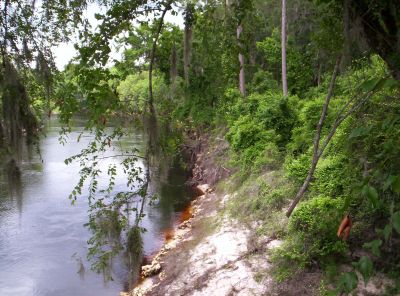 Where the Withlacoochee River runs into the Suwannee River in north, central Florida, is the Suwannee River State
Park. It is located on Highway 90 where the highway crosses the river. One of the first Florida state parks, it was
originally only 300 acres which was purchased in 1936.The park now consists of over 1,800 acres in three counties. It
has hiking trails along the river banks and modern camping facilities. Hiking, camping, and picnics are just
a few of the activities which can be enjoyed in this beautiful park. There is also a concrete boat ramp where boats on trailers can be launched. The park is part of the Suwannee River Canoe Trail.
Where the Withlacoochee River runs into the Suwannee River in north, central Florida, is the Suwannee River State
Park. It is located on Highway 90 where the highway crosses the river. One of the first Florida state parks, it was
originally only 300 acres which was purchased in 1936.The park now consists of over 1,800 acres in three counties. It
has hiking trails along the river banks and modern camping facilities. Hiking, camping, and picnics are just
a few of the activities which can be enjoyed in this beautiful park. There is also a concrete boat ramp where boats on trailers can be launched. The park is part of the Suwannee River Canoe Trail.
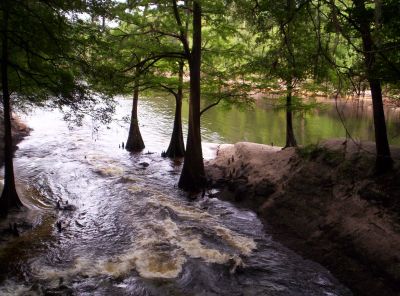 There are several well marked hiking trails in the park. Some of the trails run along the river bank and open on to
scenic views of the river at regular intervals. Many of the trails are interconnected and a longer hike can be planned
by going on to the next trail in the system. The Lime Sink Trail is a very interesting hike. It runs along the banks of
a large creek which empties into the Suwannee River. There are wooden walking bridges where the trail crosses the rushing
creek. By following the creek upstream, you can see a lime rock sink hole where part of the creek water runs into an
underground cave system. Underground caves are common in this area of Florida and many are filled with water.
There are several well marked hiking trails in the park. Some of the trails run along the river bank and open on to
scenic views of the river at regular intervals. Many of the trails are interconnected and a longer hike can be planned
by going on to the next trail in the system. The Lime Sink Trail is a very interesting hike. It runs along the banks of
a large creek which empties into the Suwannee River. There are wooden walking bridges where the trail crosses the rushing
creek. By following the creek upstream, you can see a lime rock sink hole where part of the creek water runs into an
underground cave system. Underground caves are common in this area of Florida and many are filled with water.
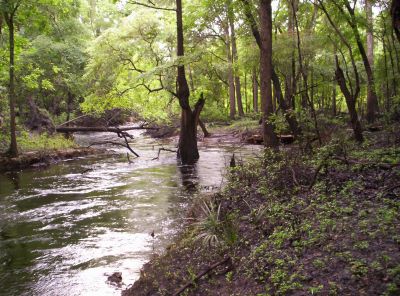 The creeks run through swampy areas and much of the creek beds are lined with lime rock. Huge old cypress trees grow in the water and send what are called cypress knees up out of the water all around the tree. Cypress knees are part of the root system of the cypress trees that reach up into the air from under water and along the muddy creek banks. Oaks, maples, sweet-gum, and many other varieties of trees line the creek and river banks closing over the trails in places so that you
are hiking through a leaf roofed tunnel. Cat squirrels are abundant in the trees. Along the trails you may catch a glimpse
of raccoons, opossums, rabbits, wild turkeys, or white tail deer. Alligators are also occasionally seen in this area.
The creeks run through swampy areas and much of the creek beds are lined with lime rock. Huge old cypress trees grow in the water and send what are called cypress knees up out of the water all around the tree. Cypress knees are part of the root system of the cypress trees that reach up into the air from under water and along the muddy creek banks. Oaks, maples, sweet-gum, and many other varieties of trees line the creek and river banks closing over the trails in places so that you
are hiking through a leaf roofed tunnel. Cat squirrels are abundant in the trees. Along the trails you may catch a glimpse
of raccoons, opossums, rabbits, wild turkeys, or white tail deer. Alligators are also occasionally seen in this area.
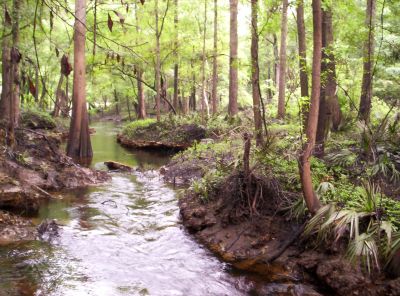 Palmettos, grape vines, and many varieties of water plants grow along the trail. The trees over the trails are hung with
Spanish moss, a gray colored air plant that attaches to the tree limbs and gets nutrients from the air. Be cautious where
you are putting your feet. There are several species of poisonous snakes that live along the creek banks. There are also
poisonous plants growing along the sides of the trail. Just touching the poison ivy could make you break out in a nasty rash. The trails are kept cleared of vegetation and park rules require that you stay on the marked trails while hiking.
Palmettos, grape vines, and many varieties of water plants grow along the trail. The trees over the trails are hung with
Spanish moss, a gray colored air plant that attaches to the tree limbs and gets nutrients from the air. Be cautious where
you are putting your feet. There are several species of poisonous snakes that live along the creek banks. There are also
poisonous plants growing along the sides of the trail. Just touching the poison ivy could make you break out in a nasty rash. The trails are kept cleared of vegetation and park rules require that you stay on the marked trails while hiking.
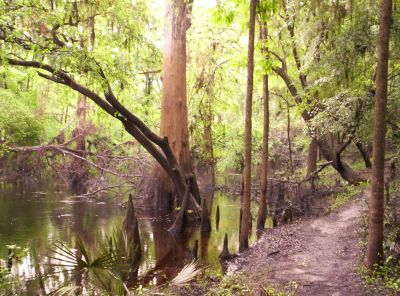 Many different kinds of birds can be seen and photographed while hiking the trails. Mockingbirds, blue jays, and smaller birds are abundant in the trees around the trails. You may see a large palliated woodpecker or a kingfisher in the park. The water has several species of catfish, brim, bass, gar, and other fresh water fish. Fishing is allowed in the park. A valid
Florida fresh water fishing license is required for any fisherman over the age of 16. Those younger than 16 may fish without
a license. None of the individual trails are over a mile long, but you can take longer hikes by moving onto the next trail
in places where they intersect. When walking along the trails that lead through the park, you will need a good set of hiking
boots and plenty of insect repellant.
Many different kinds of birds can be seen and photographed while hiking the trails. Mockingbirds, blue jays, and smaller birds are abundant in the trees around the trails. You may see a large palliated woodpecker or a kingfisher in the park. The water has several species of catfish, brim, bass, gar, and other fresh water fish. Fishing is allowed in the park. A valid
Florida fresh water fishing license is required for any fisherman over the age of 16. Those younger than 16 may fish without
a license. None of the individual trails are over a mile long, but you can take longer hikes by moving onto the next trail
in places where they intersect. When walking along the trails that lead through the park, you will need a good set of hiking
boots and plenty of insect repellant.
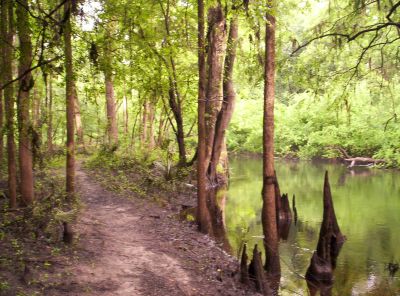 Mosquitoes and yellow flies are plentiful along the river and creek banks. You should also carry drinking water on the hikes. During most of the year it is hot and humid in this area. Sudden afternoon thunderstorms are frequent in the spring
and summer. A water proof or Ziplock plastic bag should be carried to protect cameras or other items that might be damaged
by water. At intervals along most of the trails, there are benches where hikers can take a break to cool off. The Suwannee
River Trail and the Balanced Rock Trail both run along the bank of the Suwannee River, then loop back around and through the
wooded areas farther from the river bank. The Lime Sink Run Trail follows a creek which empties into the river, going up
one side of the creek, crossing it, then coming back down the other creek bank.
Mosquitoes and yellow flies are plentiful along the river and creek banks. You should also carry drinking water on the hikes. During most of the year it is hot and humid in this area. Sudden afternoon thunderstorms are frequent in the spring
and summer. A water proof or Ziplock plastic bag should be carried to protect cameras or other items that might be damaged
by water. At intervals along most of the trails, there are benches where hikers can take a break to cool off. The Suwannee
River Trail and the Balanced Rock Trail both run along the bank of the Suwannee River, then loop back around and through the
wooded areas farther from the river bank. The Lime Sink Run Trail follows a creek which empties into the river, going up
one side of the creek, crossing it, then coming back down the other creek bank.
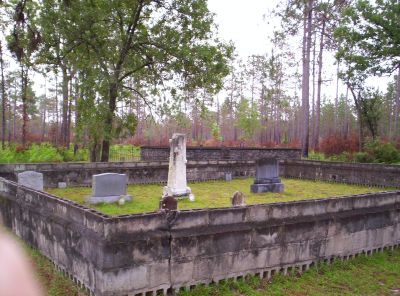 The Sand Hills Trail goes out through the pine forests which grow along the river banks. This trail passes by the old Columbus cemetery with graves from the early to mid 1800s in it. The town of Columbus once stood on the river bank at
the junction of the Suwannee and the Withlacoochee Rivers. There was once a large saw mill at the site of the town and
ferry boats carried passengers and wagons across both rivers. The cemetery and a few large pieces of sawmill and railroad
equipment are all that remains of the town. A railroad bridge was constructed across the Suwannee River in the 1800s.
The town of Columbus was served by both rail and steam ships during that time.
The Sand Hills Trail goes out through the pine forests which grow along the river banks. This trail passes by the old Columbus cemetery with graves from the early to mid 1800s in it. The town of Columbus once stood on the river bank at
the junction of the Suwannee and the Withlacoochee Rivers. There was once a large saw mill at the site of the town and
ferry boats carried passengers and wagons across both rivers. The cemetery and a few large pieces of sawmill and railroad
equipment are all that remains of the town. A railroad bridge was constructed across the Suwannee River in the 1800s.
The town of Columbus was served by both rail and steam ships during that time.
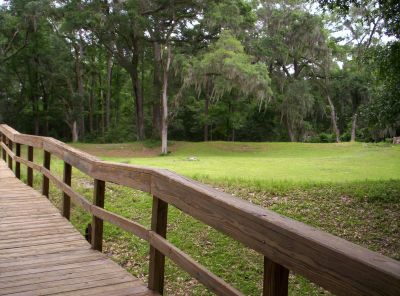 At the time of the American Civil War, Confederate Army earth works were put in place to defend this important river crossing
from raiding northern troops. An attempt was made to attack the river crossing, but the Union troops were defeated and
turned back in the Battle of Olustee before they ever reached the town of Columbus. The Confederate earth works can still
be seen. A wooden walkway runs over the earth works so that foot traffic does not cause erosion to this historic site.
At the time of the American Civil War, Confederate Army earth works were put in place to defend this important river crossing
from raiding northern troops. An attempt was made to attack the river crossing, but the Union troops were defeated and
turned back in the Battle of Olustee before they ever reached the town of Columbus. The Confederate earth works can still
be seen. A wooden walkway runs over the earth works so that foot traffic does not cause erosion to this historic site.
 The trail crossing the old Confederate earth works follows the river bank on down to an overlook which has been constructed
on the river bank to provide a scenic view of the two rivers running together. The wooden walkway leading out to the overlook has high railings and wire netting for safety. The foundations of the first railroad bridge can be seen from the
walkway. A new highway and railroad bridge were built farther down river and are still in use. Large steel saw mill pulleys
and parts of old railway cars are on display beside the path to the overlook. Plaques beside many of the park trails
give information about the flora, fauna, and history of the area.
The trail crossing the old Confederate earth works follows the river bank on down to an overlook which has been constructed
on the river bank to provide a scenic view of the two rivers running together. The wooden walkway leading out to the overlook has high railings and wire netting for safety. The foundations of the first railroad bridge can be seen from the
walkway. A new highway and railroad bridge were built farther down river and are still in use. Large steel saw mill pulleys
and parts of old railway cars are on display beside the path to the overlook. Plaques beside many of the park trails
give information about the flora, fauna, and history of the area.
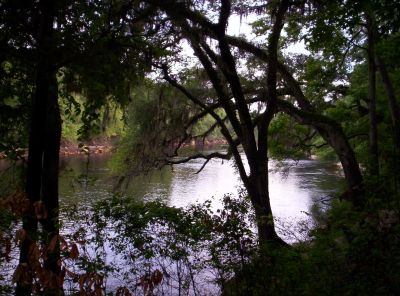 A park ranger station is located at the entrance. Two covered picnic pavilions stand in a well kept grassy recreational
area right on the river bank. Several other picnic sites with tables, grills, and plenty of cool shade are available along the river bank. Restrooms and water fountains are conveniently near the picnic area. Close by is a children's
playground with swings, slides, and monkey bars to play on. Vegetation in the park is managed to keep only native Florida
plants and trees in place. Any non-native plants or trees are removed from the park so that it appears much as it did when
the first Europeans came into the area.<
A park ranger station is located at the entrance. Two covered picnic pavilions stand in a well kept grassy recreational
area right on the river bank. Several other picnic sites with tables, grills, and plenty of cool shade are available along the river bank. Restrooms and water fountains are conveniently near the picnic area. Close by is a children's
playground with swings, slides, and monkey bars to play on. Vegetation in the park is managed to keep only native Florida
plants and trees in place. Any non-native plants or trees are removed from the park so that it appears much as it did when
the first Europeans came into the area.<
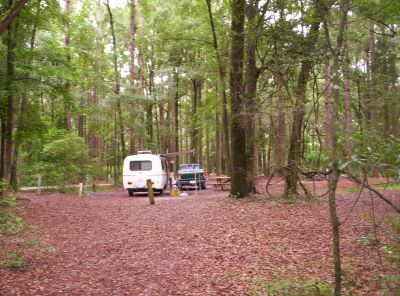 In addition to the picnic area, the park has 31 campsites for overnight camping. Each campsite is equipped with electricity, running water, a picnic table, and a fire ring that has a built in grill. A bath house is in the center of the campground
with restrooms, showers, and laundry facilities. The park also has two remote youth tent camping sites that can be reserved
by non-profit youth groups. Restroom facilities are close to these sites. Information about reserving the youth camp sites, family cabins, or the family campsites can be found in the links section of this web page.
In addition to the picnic area, the park has 31 campsites for overnight camping. Each campsite is equipped with electricity, running water, a picnic table, and a fire ring that has a built in grill. A bath house is in the center of the campground
with restrooms, showers, and laundry facilities. The park also has two remote youth tent camping sites that can be reserved
by non-profit youth groups. Restroom facilities are close to these sites. Information about reserving the youth camp sites, family cabins, or the family campsites can be found in the links section of this web page.
**************************************************
~~To reserve prepaid camping facilities in the park~~
**************************************************
**************************************************
Reserve America ~~ Phone 1-800-326-3521